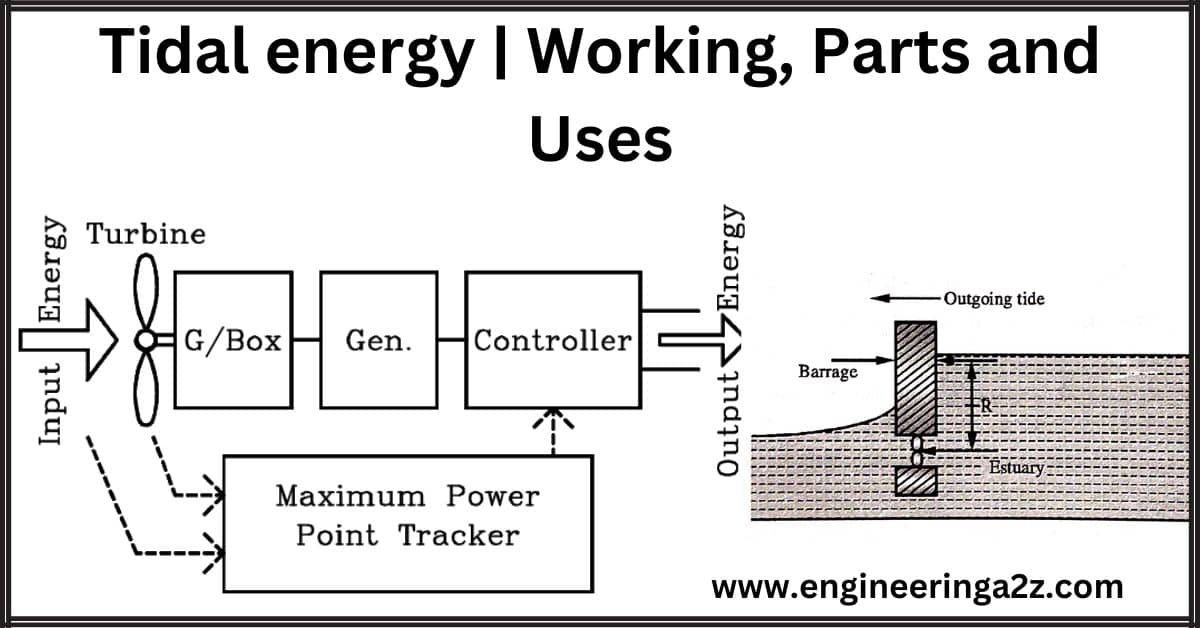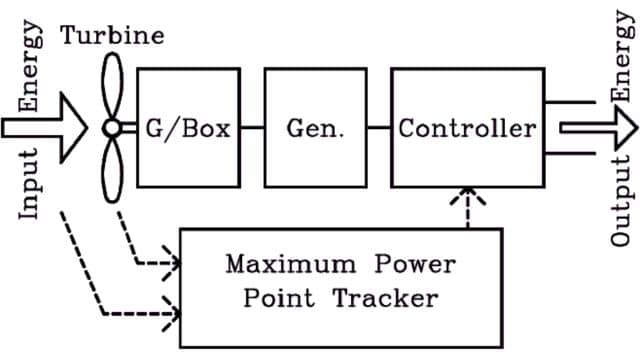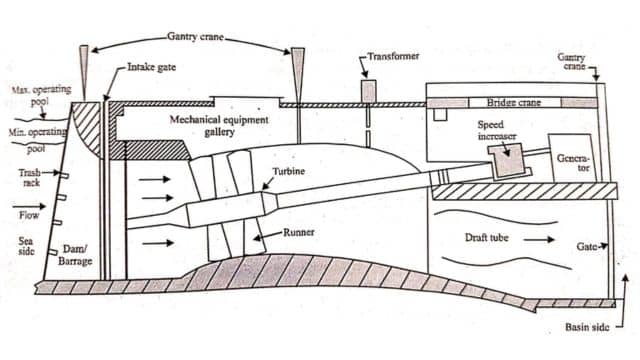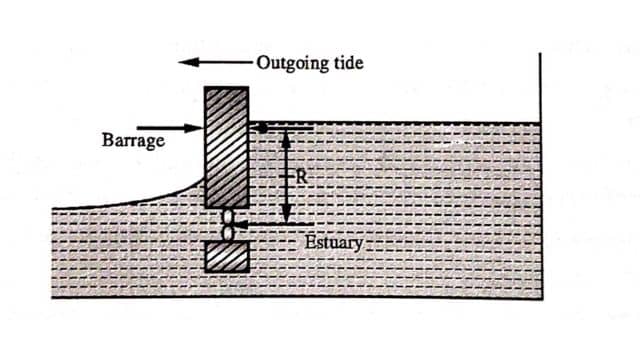
Table of Contents
Tidal Energy
Tidal energy is a type of renewable energy that harnesses the power of ocean tides to generate electricity. It requires specific conditions, such as a tidal range (the difference between high and low tides) of at least 4 meters and suitable topography like estuaries or certain types of bays, to make it cost-effective.
To capture tidal energy, a structure called a barrage is built across a suitable estuary. This creates a basin behind the barrage. As the tides rise and fall, a large amount of water moves back and forth, carrying a significant amount of energy. The barrage is designed to capture this energy.
Inside the barrage, there is a turbine located in the water route. When the tide goes back, the potential energy stored in the water due to the difference in water levels across the barrage is converted into kinetic energy. The water flows through the turbine, causing its blades to rotate. This rotation generates mechanical power.
Finally, this mechanical energy is converted into electrical energy using a generator that is connected to the turbine. The generator produces electricity, which can then be used to power homes, businesses, and other electrical devices.

In simple terms, tidal energy harnesses the power of moving water in tides by using a barrage, turbine, and generator to convert it into electricity.
Parts of the Tidal Plant
The tidal power plant has the following constructional parts:
(a) Barrage: It is a dam of low head and requires the following features:
- Less sloppy toward the ocean and basin side.
- Able to withstand the shock load of tides and waves.
- Low height and shorter in length to minimize the cost of construction.
- Steel foundation frame and channels will be embedded in the ducts within the barrage for the turbine and gates steel foundation.
(b) Sluice gates: The gates are opened by water pressure and no mechanical means is required.

(c) Power plant and turbine: The plant size is larger because of the low water head. The Kaplan or bulb-type turbine is used to operate with a low head. The entire turbine generator unit is submerged in the water.
(d) Basin: The basin can be single, pair, or multiple types and have different designs.
Working of Tidal Plants
A tidal energy plant is similar in design and construction to a hydroelectric plant that generates electricity from flowing water. However, there are some differences. In a tidal plant, the turbine’s rotational speed is much slower, about 1/10th of the rotational speed of a hydropower plant, typically ranging from 50 to 100 revolutions per minute (rpm). This slower speed helps reduce wear and tear on the turbine.
In a tidal plant, a large volume of water needs to pass through the barrage in a relatively short time. While the turbine’s slower speed reduces wear, more turns are needed to accommodate the larger volume of water. This means that more blades or vanes are installed in the barrage to efficiently capture tidal energy.
The amount of energy produced by a tidal energy scheme varies depending on the location and time. The average electric power output is limited by the twice-daily ebb and flood of tides. On average, the electricity generated from tidal energy is less than 40% of the installed generating capacity. Unlike energy from river dams, tidal energy availability is fully predictable on a daily, monthly, and annual basis. However, it needs to be either stored or integrated with other sources of generation that can adjust to fluctuations in tidal generation.

Most tidal energy plants have a large dam-like structure with an installed capacity of 240 MW. These plants primarily use Kaplan turbines, which are designed for low rotational speeds. They also have a small bank of sluice gates. The working of a tidal plant is similar to a hydro scheme but on a much larger scale due to the size of the dam.
In simple terms, a tidal plant works by allowing the flood tide to enter through a turbine passage in the barrage located in estuaries. The incoming water rotates the turbine runner in a forward direction, generating power. When the tide goes out, the water flows from the basin to the sea, causing the turbine runner to rotate in the reverse direction. Power generation occurs during both the incoming and outgoing tides, using different configurations of turbine and generator, such as bulb turbines, tubular turbines, and rim generators.
Economic and Environmental Considerations
(a) Economic Considerations: The following are the economic considerations:
- The barrage capital cost is high, compared to river dams.
- Costly efforts to overcome the objections through further studies.
- The relatively low head of water above the turbine restricts the capacity of individual generators to about 25-50 MW.
- The long construction period for the larger schemes and low load factors of about 23- 28% would result in high unit costs of energy and currently remain uncompetitive with conventional fossil fuel alternatives.
- Large payback time (more than 20 years).
(b) Environmental Considerations: The large-scale tidal barrages suffer from the following types of environmental problems, depending upon the location of the scheme
- Barrages block navigation, however, the lock gates allow some traffic, but it is a slow and costly alternative.
- Barrages and channels make it difficult for wildlife and fish to migrate
- Barrages change the size and location of the area that is alternatively wet and dry during the tidal, thereby obliging the plant and animal life to (adapt or move) to the new location.
- Barrages change the tidal regime downstream, thereby impacting the hydrology and salinity of these areas.
- The birds migrate from the local sea area. Estuaries serve as a nursery for many marine organisms and this habitat is being altered by constructing large power plants.
Advantages of Tidal energy
- Renewable and Predictable: Tidal energy is a renewable energy source that relies on the gravitational forces of the moon and the sun. Tides occur reliably and are highly predictable, making tidal energy a consistent and reliable source of power.
- High Energy Density: Tidal energy has a high energy density, meaning that a relatively small area can generate a significant amount of power. Tidal currents are much denser than air, allowing for efficient energy extraction and the generation of substantial amounts of electricity.
- Environmentally Friendly: Tidal energy is a clean and environmentally friendly energy source. It produces no greenhouse gas emissions or air pollutants during operation, which helps mitigate climate change and reduce air pollution. Tidal energy projects also have minimal impact on water quality and marine ecosystems when properly designed and managed.
- Long Lifespan and Low Maintenance: Tidal energy infrastructure, such as turbines and barrages, has a long lifespan and requires minimal maintenance once installed. This results in a reliable and low-maintenance energy source, reducing operational costs and ensuring consistent power generation over an extended period.
- Energy Independence and Security: Tidal energy offers the potential for energy independence and security. Countries with access to suitable tidal resources can harness their own domestic energy potential, reducing dependence on imported fossil fuels. This enhances energy security and reduces exposure to fuel price fluctuations and geopolitical uncertainties associated with energy imports.
Disadvantages of Tidal energy
Here are three disadvantages of tidal energy:
- Limited Site Availability: Tidal energy is highly site-specific, requiring specific conditions such as a significant tidal range and suitable topography like estuaries or bays. This limits the number of viable locations for tidal energy projects, which can restrict its widespread adoption and deployment.
- High Initial Costs: The upfront costs of designing and constructing tidal energy infrastructure can be significant. Building barrages, turbines, and other necessary components can be expensive, especially for large-scale projects. These high initial costs can pose financial challenges and require substantial investment.
- Environmental Impact: While tidal energy is generally considered a clean energy source, the installation and operation of tidal energy projects can have environmental impacts. Construction activities can disrupt marine habitats, alter sediment transport, and affect the movement of aquatic species. Noise and electromagnetic fields generated by turbines may also potentially impact marine organisms. Proper site selection, impact assessment, and mitigation measures are necessary to minimize these potential environmental effects.
It’s worth noting that ongoing advancements in technology, as well as ongoing research and development efforts, aim to address these disadvantages and make tidal energy more economically viable, environmentally sustainable, and accessible.
Applications of Tidal energy
- Electricity Generation: The primary use of tidal energy is for electricity generation. Tidal energy projects capture the kinetic energy of moving water during the rise and fall of tides. This energy is then converted into electrical energy through the rotation of turbines and subsequent power generation. The electricity generated can be supplied to local communities, and industries, or integrated into the power grid.
- Grid Stabilization and Peak Demand Management: Tidal energy can contribute to grid stabilization and management of peak electricity demand. As tidal cycles are predictable, the energy generated from tides can be utilized to meet peak demand periods when electricity usage is high. Tidal energy can provide a consistent and reliable source of power to supplement other intermittent renewable energy sources like solar and wind.
- Desalination: Tidal energy can be used in desalination processes to produce freshwater from seawater. The energy generated from tides can power desalination plants, which use reverse osmosis or other methods to remove salt and impurities from seawater, making it suitable for drinking, irrigation, or industrial purposes. Tidal energy-powered desalination can provide a sustainable solution for regions facing water scarcity.
- Aquaculture and Mariculture: Tidal energy installations can create artificial structures that serve as habitats for marine life. These structures can foster the growth of various species, supporting aquaculture and mariculture activities. Tidal energy projects can be designed to minimize negative impacts on marine ecosystems while providing opportunities for sustainable seafood production and conservation efforts.
It’s important to note that the specific applications and uses of tidal energy can vary depending on the available resources, site characteristics, and local energy needs. Tidal energy continues to be explored for its potential in other areas such as hydrogen production, thermal energy storage, and offshore platform operations.
Frequently Asked Questions (FAQs)
-
What is tidal energy?
Tidal energy is the power generated from the natural motion of tides, harnessed to produce electricity and renewable energy.
-
What are the applications of tidal energy?
1. Tidal energy can be used to generate electricity by utilizing tidal turbines or barrages, providing a reliable and sustainable power source.
2. Tidal energy can also be employed in desalination processes, where the energy is used to power the conversion of seawater into freshwater, addressing water scarcity issues. -
What are the advantages of tidal energy?
1. Environment-friendly: Tidal energy is a clean and renewable energy source, producing no greenhouse gas emissions or air pollution.
2. Highly predictable energy source: Tides are predictable and occur regularly, ensuring a reliable and consistent energy supply. -
What are tides?
Tides are the regular rise and fall of ocean water caused by the gravitational pull of the moon and sun.
Read Also:
- Solar Cookers | Working Principle, Construction, and Applications
- DIAC | Construction | Working and V-I Characteristic
- Electric Traction | Speed-Time Curve
- Difference Between A.C. and D.C.
- Energy Management | Need and Environmental Aspects
- MHD | Magneto Hydro Dynamic Generation











Leave a Reply